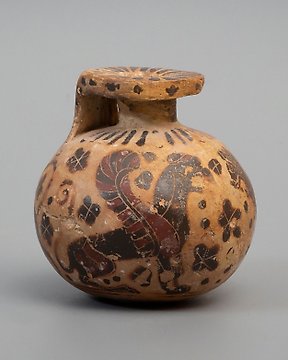
Etrusco-corinzio Ceramica Aryballos con animali. 6 cm H. c. 570 a.C..
N. 85987389

N. 85987389

ITEM: Statuette of a horse
MATERIAL: Pottery
CULTURE: Chinese, Tang Dynasty
PERIOD: 618 - 907 A.D
DIMENSIONS: 560 mm x 530 mm x 200 mm
CONDITION: Good condition. Includes Thermoluminescence test by Laboratory Kotalla (Reference 02PR101220)
PROVENANCE: Ex Belgian private collection (2022), Ex English art gallery, Ex English private collection, D.R, acquired in 1990s
Comes with Certificate of Authenticity and Export Licence. If you are from outside the European Union, we will have to apply for the export licence again for your country, this takes 3 to 5 weeks and has a cost of 5% of the hammer price, this amount will be added to the final invoice.
Due to the fragility of this piece, it can only be shipped within the European Union, United Kingdom and neighbouring countries that can be transported by road by private courier (door to door) and costs 350 euros, 100 euros for Spain.
The Tang Dynasty, which ruled China from 618 to 907 AD, is often regarded as one of the most glorious periods in Chinese history, characterized by political stability, economic prosperity, and remarkable cultural achievements. Established by the Li family, the dynasty saw significant advancements in various fields, including poetry, painting, calligraphy, and technology. The Tang Dynasty was renowned for its cosmopolitanism, with influences from Central Asia, India, and the Middle East contributing to its vibrant cultural landscape. Under Tang rule, China experienced a golden age of literature and art, with figures like Li Bai and Du Fu flourishing in poetry and artists such as Wu Daozi making significant contributions to painting.
During the Tang Dynasty, the tradition of producing horse statuettes continued, reflecting the enduring significance of horses in Chinese society. These horse statuettes, often referred to as Minqi horse sculptures, maintained the artistic excellence established in earlier periods and further developed under Tang patronage. Crafted from various materials such as ceramic, metal, and stone, these sculptures depicted horses in various poses, showcasing their strength, elegance, and vitality. Some statuettes also featured intricate details such as ornamental trappings and saddlery, highlighting the craftsmanship of Tang artisans.
The Tang Dynasty’s Minqi horse statuettes not only served as decorative items but also held symbolic and cultural significance. Horses were not only essential for transportation and warfare but also symbolized wealth, power, and prestige. Therefore, these sculptures often adorned the tombs of the elite as burial goods, reflecting beliefs in the afterlife and serving as expressions of social status.
这个精美的陶瓷侍者是在许多人认为是中国的黄金时代–唐朝制作的。正是在这个时候,中国杰出的技术和审美成就向外部影响开放,导致引进了许多新的自我表达形式,再加上内部创新和相当的社会自由。唐朝还诞生了印刷小说、重要的音乐和戏剧遗产以及许多中国最知名的画家和艺术家。唐朝创建于公元618年6月18日,当时李氏家族从之前的隋朝最后的破碎残余中夺取了权力。这个政治和王权政权的寿命很长,持续了近300年。前期和早期唐朝领导人的皇权愿望导致了前所未有的财富,从而使社会经济相当稳定,贸易网络得到发展,并为中国爆炸性的人口(估计在公元8世纪约有5000万人口)带来了巨大的城市化。唐朝统治者借鉴了早期的做法,完整地保留了许多行政结构和制度。即使在这一时期的末期,王朝和政府机构退出了帝国的管理–他们的权威受到了地方叛乱和被称为节度使的地区长官的破坏–这些系统也是如此完善,以至于它们继续运作。
这个时代创造的艺术作品是中国最伟大的文化成就之一。这是中国诗歌和绘画最伟大的时代,雕塑也得到了发展(尽管在政权的后期,亲道教的政府压制了佛教的信仰,佛教的雕塑明显减少)。令人不安的是,皇权的最终衰落,以及907年6月4日王朝的正式结束,几乎没有影响到伟大的艺术更替。在唐朝,对墓葬中可包含的物品数量进行了限制,这一数量由个人的社会等级决定。尽管有这些限制,出土的墓葬陈设–被称为明器–种类惊人。整个陶俑队伍–代表武士、动物、艺人、音乐家、监护人和其他各类必要的助手–都与死者合葬,以便为来世提供服务。战士(lokapala)被安排来保卫死者,而马/骆驼则被提供给运输,官员则在来世管理他的财产。然而,在所有不同类型的明器中,没有比成熟的女朝臣的雕塑更优雅或迷人的了,她们被称为–相当不公平地–“胖女人”。这些精彩的表现主义雕塑代表了中国唐代的理想化之美,同时也展示了雕塑大师为达到效果而夸大特征,以及纯粹的优雅执行。
其最初的用途很可能是明器,是为了陪葬而设计的兵马俑,目的是为了陪伴死者来世的保护、服务和陪伴。
明器包括日常用具、乐器、武器、盔甲,以及死者的帽子、罐子、竹席等私密物品。明器还可以包括士兵、仆人、乐师、马球手、房屋和马匹的塑像、精神代表而非真人。明器在某些时期的广泛使用,可能是为了节约成本,维护礼制的形象,也可能是为了把死人和活人的境界分开的新思想。
唐代的明器虽然特别流行,但各个历史时期的明器都有发现,本件是特别早的例子。
Come fare acquisti su Catawiki
1. Scopri oggetti speciali
2. Fai l’offerta più alta
3. Paga in tutta sicurezza